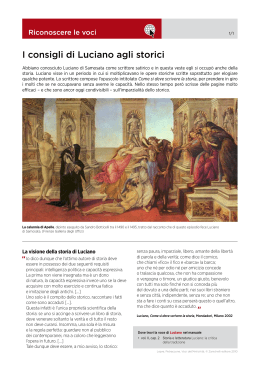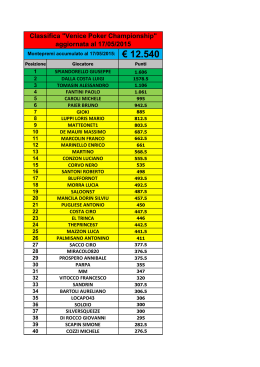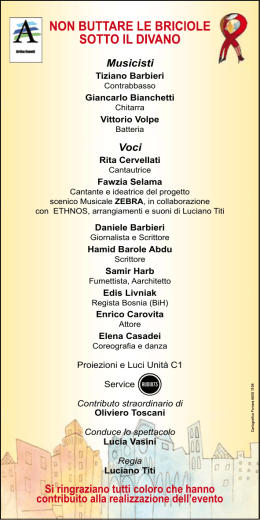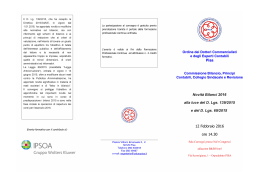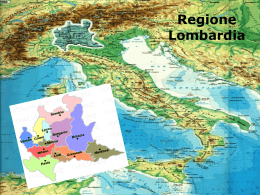Biblioteca Comunale - Luciano Bonacini Mostra 2006 09.FH11 Thu May 18 15:06:45 2006 Pagina 1 C Luciano Bonacini was born in Scandiano (RE) in 1954. He graduated in psychology from the University of Padua and dedicated his photographic research and activity to the expression of beauty as perception of the invisible, the imponderable. He has held many personal and collective exhibitions in prestigious Italian and foreign institutions and has been hosted by renowned figures in contemporary and world photography. He won first prize as the best Italian portrait artist at The European Agfa Portrait Award 93 and at the Kodak European Gold Award 94. His photographs are present in diverse International museums and in Italian and foreign public and private collections. Y CM MY CY CMY K LUCIANO BONACINI GRAFICHEWWW.ANDREIS.ITMALCESINE Luciano Bonacini nasce a Scandiano (RE) nel 1954. Laureato in Psicologia presso lUniversità di Padova, ha dedicato la sua ricerca e attività di fotografo allespressione della bellezza come percezione dellinvisibile, dellimponderabile. Ha tenuto numerose esposizioni personali e collettive in prestigiose istituzioni nazionali e straniere ed è stato ospite di illustri personaggi della fotografia mondiale e contemporanea. Ha vinto il primo premio come miglior ritrattista italiano ai concorsi The European Agfa Portrait Award 93 e al Kodak European Gold Award 94. Sue fotografie sono presenti in diversi Musei Internazionali e in collezioni pubbliche e private italiane e straniere. M Artist Photographer Photo Books: Limage de toi (1986) Photographies (1988) Metà ta physikà (2001) Collection Privée (2006) Retrospective (2006) Il Ramo della Bellezza Colori compositi Malcesine, Lake Garda · San Rocco Church Informazioni / Information: Assessorato alla Cultura · Comune di Malcesine Tel. 045 6570499 · Fax 045 6570502 · [email protected] © 2006 Luciano Bonacini - All right reserved LUCIANO BONACINI © 2006 Luciano Bonacini - All right reserved Malcesine, lago di Garda · Chiesa di San Rocco Comune di Malcesine Il Ramo della Bellezza The Branch of Beauty Malcesine · Chiesa di San Rocco · dal 3 Giugno al 31 Luglio 2006 UN PASTORE ERRANTE DI LANDA IN LANDA Folgorazioni avvolte di silenzio. Un silenzio che ha a che fare con Dio e con le rivelazioni ultime, sospeso e ingordo di bellezza come solo lodore di eternità sa dispensare. Le opere di Luciano Bonacini sono frammenti rubati ad un sempre atavico e ancestrale; tutto tranne fotografie, piuttosto privati cosmodromi sul mistero del vivere e del morire. Se il linguaggio dellimmagine, nella sua accezione oggi più frequentata, è spesso quello oggettivo e spudorato del flash negli occhi, del caos rutilante, della tecnologia più esibita, qui siamo di fronte allesatto contrario: la bellezza del dettaglio, lunicità di un volto, a dire lessenza dellanimo umano, sempre profondamente uguale a se stessa eppure ogni volta, ad ogni scatto, così sorprendentemente diversa, mutevole, duttile alle rughe che increspano la pelle di un nuovo segno. Non è un caso che Luciano ami spogliare i corpi di tutto ciò che è cronaca, coincidenza, maschera, lasciando che sia la pelle a fare da voce narrante. La pelle che, come la scorza di un albero secolare, come la buccia di un frutto, svela il tema natale di un viaggio benedetto, lordine superiore che governa le cose, la mano ispirata di un compositore rimasto nellombra. Il nudo femminile è allora un paesaggio su cui scrivere e a cui chiedere, così come quelle distese mozzafiato - siano esse Kenia, Arizona o Bali, o ancora quelle animate dai giganti frondosi di Central Park - nascondono lintimo pulsare di unumanissima essenza, di un corpo antico, macerato dagli anni e dalle stagioni. Viene da sorridere guardando Luciano, abbarbicato allobiettivo come ad unarma di pace e di sapienza: lo si crederebbe un contadino incapace di staccarsi dalla propria terra, un pastore errante di landa in landa, un medico di anime o un guaritore. Uno che interroga il mondo con quotidiana, caparbia devozione, cercando le segrete assonanze tra la terra e il cielo, il sigillo di unalleanza perduta. E per fare questo occorre mettere a tacere ogni rumore esterno, ogni interferenza; occorre trovare in sé la giusta corda della meditazione profonda, la verticale dellequilibrista sospeso sullabisso. In ogni opera riaffiora una millenaria lentezza, un tempo lasciato decantare senza fretta come un vino dannata: è quello dellattesa paziente, e vigile del santo a cogliere il miracolo, lapparizione di un dettaglio che sollevi lanima dal corpo. Strane alchimie di cui oggi sè persa la formula. Non posso fare a meno di ricordare il primo incontro con larte di Luciano: lei era Melanie, icona di una fisicità primitiva (animalesca) quanto regale; la sua pelle di bronzo, accesa da una luce mattutina, sembrava danzare nel nulla, come se tutto quanto intorno - quei campi della bassa, quel casolare con la sua memoria fatiscente, quella strada da carrettieri, sterrata come unantica via carovaniera - fosse stato lì solo per abbracciarne il passaggio. Eravamo in una galleria; improvvisamente, davanti a quella manciata di scatti, nessuno dei presenti più fiatava. Non era eccitazione, né semplice meraviglia: era una pacata commozione. Come a cospetto di unalba boreale, di una notte nel deserto o di uno scampolo di campagna senese, con il suo contrappunto di linee e colori. Come se ognuno di noi stesse respirando il riverbero di questa vertigine. Luciano è questo, e la sua biografia sono le sue opere. Ogni gesto aggiunto non serve a dirne di più. Qui sta la sua verità, nei gesti vellutati con cui scrive, cura, si sporca mani e piedi; gli occhi allora si inumidiscono, il cuore si fa stanco e traboccante. Uno dopo laltro, questi scatti iniziano così a venire al mondo e a portare alla luce nicchie insospettate. Donne, soprattutto, ma anche squarci di mondo, frammenti di destini spesi e mancati, briciole di assoluto: inni alla vita che da soli dicono più di qualsiasi commento. Siano allora queste parole (inutili e affettuose, come solo la scrittura sa essere) niente più di una restituzione, una carezza sul cuore tracciata in punta di pennino, come un arabesco. Elide Bergamaschi Biblioteca Comunale - Luciano Bonacini Mostra 2006 09.FH11 Thu May 18 15:06:45 2006 Pagina 2 C M Y CM MY CY CMY K Colori compositi Elide Bergamaschi © 2006 Luciano Bonacini - All right reserved Lightning strokes wrapped in silence. Silence that has to do with God and the latest revelations, suspended and gluttonous for beauty as only the scent of eternity can dispense. The works of Luciano Bonacini are fragments stolen from an ancestral and atavistic eternity. Everything but photographs. Rather private cosmodromes on the mystery of life and death. While todays most frequent concept of the language of image is the objective and shameless language of a flash in the eye, of glowing chaos, of the most showed technology, here we are facing the exact opposite: the beauty of details, the uniqueness of a face, to express the essence of the human soul, always deeply the same as itself and yet each time, with every photo, so surprisingly different, changing, ductile to the wrinkles that ripple the skin with a new sign. It is not by chance that Luciano loves to divest bodies of all that is daily news, coincidence, mask, letting the skin narrate. Skin which, like the bark of an aged tree, like the rind of fruit, reveals the nativity theme of a blessed voyage, the superior order that governs things, the inspired hand of a composer in the background. Female nudes are a landscape whereon to write and wherefrom to ask, like those breathtaking expanses - whether in Kenya, Arizona or Bali, or those animated by the giant trees of Central Park - which hide the intimate pulsing of a totally human essence, of an antique body, steeped by years and seasons. We smile when we see Luciano, clinging to the camera as a weapon of peace and wisdom, resembling a farmer incapable of leaving his lands, a shepherd who wanders from land to land, a doctor of the soul or a healer. One who questions the world with stubborn, daily devotion, searching for secret harmonies between land and sky, the seal of a lost alliance. And in order to do this, it is necessary to tune out all external noise, every interference; or to find in oneself the right note of deep meditation, the vertical point of equilibrium of a tightrope walker, suspended over the void. Age-old slowness surfaces from every work, time left to decant without haste like a vintage wine, the time of the patient and vigil waiting of a saint ready to grasp a miracle, the appearance of a detail that raises the soul above the body. Strange alchemies with formulas lost to today. I cannot help but remember my first encounter with the art of Luciano: she was Melanie, an icon of primitive (animal) physical but also royal essence. Her bronze skin, lit up by a morning light, seemed to dance in the void, as if everything around her - those lowland fields, that farmhouse with its decrepit memories, that earthen wagon path, like an ancient caravan route - was there only to embrace her passage. We were in a gallery. Suddenly, before this handful of photos, everyone present held their breath. But this was neither excitement nor simple surprise: it was calm emotion. As when presented with an artic sunrise, a night in the desert or a fragment of Siena countryside with its counterpoint of lines and colors. As if each of us were breathing in the reverberations of this vertigo. This is Luciano and his biography is his works. Every added gesture serves no further purpose. Here we find his truth, in the velvet gestures with which he writes, handles, dirties his hands and feet. Eyes are dampened, the heart becomes tired and overflowing. These snapshots, one after the other, start to come out to the world and bring to light unexpected hidden features. Women, primarily, but also pieces of world, fragments of spent and missing destines, crumbs of the absolute: songs to life which, by themselves, say more than any worlds. So let these words (useless and loving as only writing knows how to be) be nothing but a return, a caress on the heart traced by pen point, like an arabesque. © 2006 Luciano Bonacini - All right reserved © 2006 Luciano Bonacini - All right reserved A SHEPHERD WANDERING FROM LAND TO LAND
Scarica
